It is always a matter of contention whether pruning prompts healthy growth and maximizes fruit production of tomato plants or negatively impacts them. But the reality is that it won’t harm you if you don’t prune the plant.
At the same time, if you prune it in the wrong way and at the wrong time, it is definitely going to impact your tomato plant.
Pruning is not necessary for the survival of your tomato plants, but it helps to enhance the quality and quantity of the tomatoes.
So the question is, when should pruning be done? When you notice the lower leaves of your tomato plant have turned yellow, you should pinch and prune those leaves to keep your plant healthy.
You can locate and remove the sucker. This would help your plant to utilize its energy more on fruit production. At the same time, if any long branches are found touching the ground, either support them or remove them.
Always avoid over-pruning your tomato plants, as it would damage the plant.
Go through this article to understand why you should prune tomato plants and what are the best ways to do it without impacting your plant health.
Why Should You Prune Tomato Plants?
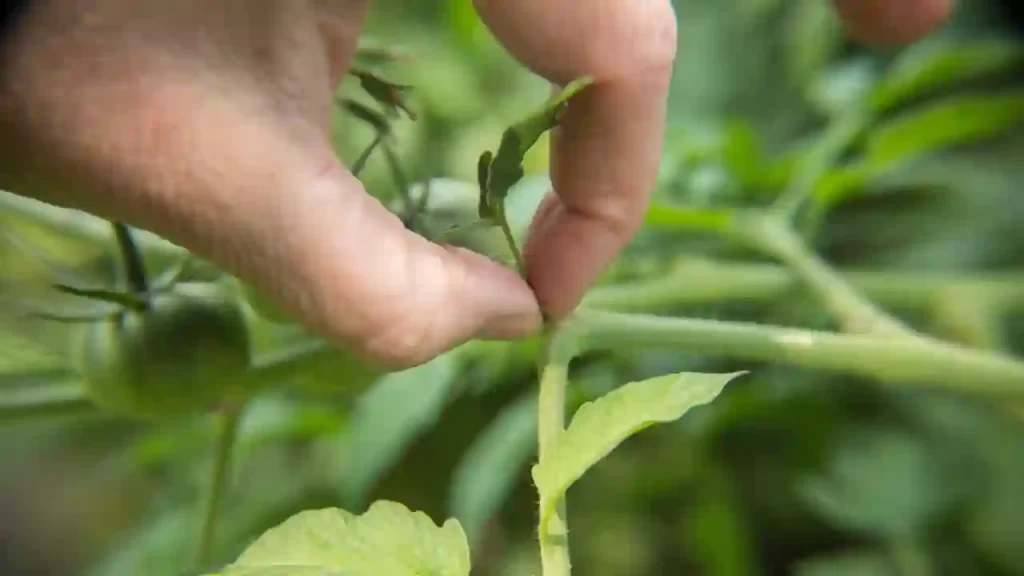
When tomato plants produce unwanted leaves and branches, the plant’s energy is wasted in the growth of those leaves and branches.
We do pruning to utilize the tomato plant’s energy correctly. And after pruning excess leaves and branches, the plant focuses on using its energy to produce fruits.
Pruning the suckers and yellow leaves of the tomato plants enhances the quality of tomatoes and keeps your plant away from many possible diseases.
If the foliage remained unpruned, they would grow new branches and set new fruits on the plant. These fruits can attract many pests and diseases.
But, if you prune tomato plants, large tomatoes can be grown on the plants, and the risk of pests and diseases are also reduced.
Good Air circulation is much needed to prevent Fungal infection, and already if fungal issues exist in your garden, then pruning can enhance the air circulation in your garden.
If air circulates around plants and fruits, it can reduce the spread of fungal infections.
However, if you have never found white spots on leaves or fungal issues in your garden, your garden already has a good air circulation facility.
Have you noticed branches of your tomato plants touching the surface of the ground? If yes, it can be a matter of concern as direct contact with soil can develop fungal diseases.
When bushy plants are grown on the ground, direct exposure of the tomato plants to sunlight is compromised, and hence plants become less efficient in producing sugar. Pruning helps to get rid of this problem.
In case you have potted or containerized tomato plants, it is very important to control the size of the plants, and pruning helps to prevent the overgrowth of the tomato plants.
Otherwise, the plants will grow outside of the pots.
Planting determinate tomato plants in pots and containers is a good idea.
Due to pruning, plants can perform the photosynthesis process correctly, as each plant part gets direct sunlight exposure, preventing the plants from various diseases and increasing quality fruit production.
When pruning Indeterminate tomato plants, it is best to prune them once they reach a height of four feet. To begin with, locate the main stems, remove all side shoots growing from them, and then remove any suckers growing from leaf axils along the stem.
Be sure only to remove one sucker per stem so as not to weaken the plant. Finally, remove any branches that are not growing in a productive manner. This includes stems that are spindly, weak, or crossing over each other.
Doing this will allow air and light to reach the plant’s fruit better, improving its overall health and productivity.
If any of the branches get too long, it is also possible to pinch them back with your fingers to keep them from getting too wild.
With proper tomato pruning and care, your Indeterminate tomatoes will produce an abundant harvest of delicious fruits!
When To Prune The Top of the Plant?
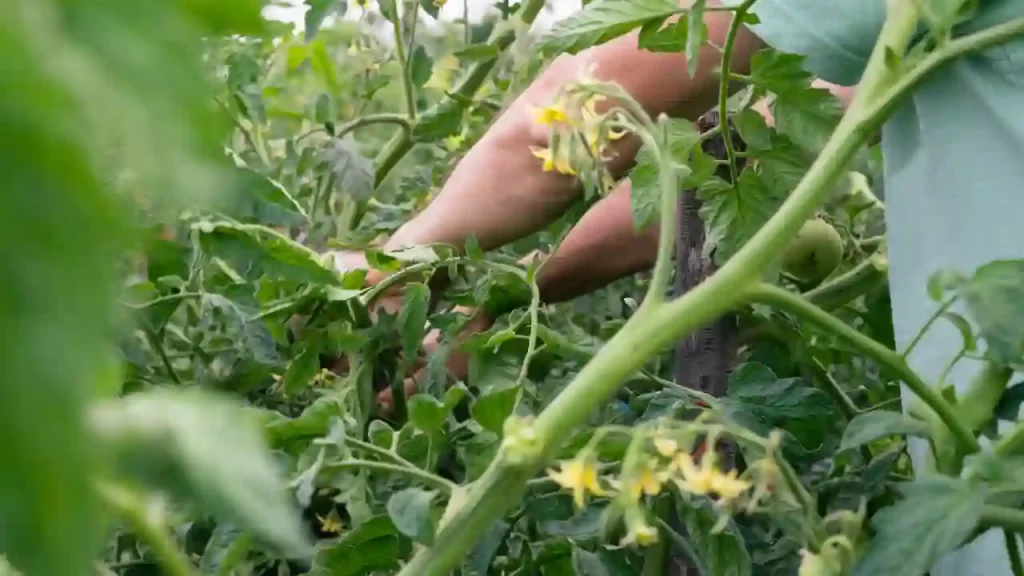
Tomatoes have limited time to ripen on the vines at the season’s end. Nothing can be better if plants utilize their most energy in fruit ripening.
To maximize the ripening period, gardeners apply the “topping the plant” technique and prune the top of the plant’s terminal shoot one month before the beginning of the frost. (Always use high-quality gardening clippers.)
With the application of this technique, the fruits absorb a good amount of nutrients, enhancing the quality of the fruits.
Even at the end of the season, with the help of pruning, you can harvest the best qualities of red, juicy and fleshy tomatoes.
Reasons To Prune Tomatoes

Pruning the tomato plants is not necessary for their survival, but it can promote the plant’s long and healthy life. It can also promote the quality production of fruits.
We, the gardeners, prune the tomato plants because of the below-mentioned reasons:
Improved airflow and less disease
Pruning the leaves of tomato plants improves the air circulation in the plants, reducing the risk of fungal infection.
It makes the plant less dense, and it becomes easier for us to spot the pests and insects in the plants quickly.
The leaves dry rapidly after rain, which invites various pests and diseases, and clipping leaves reduces disease susceptibility.
Bigger fruit
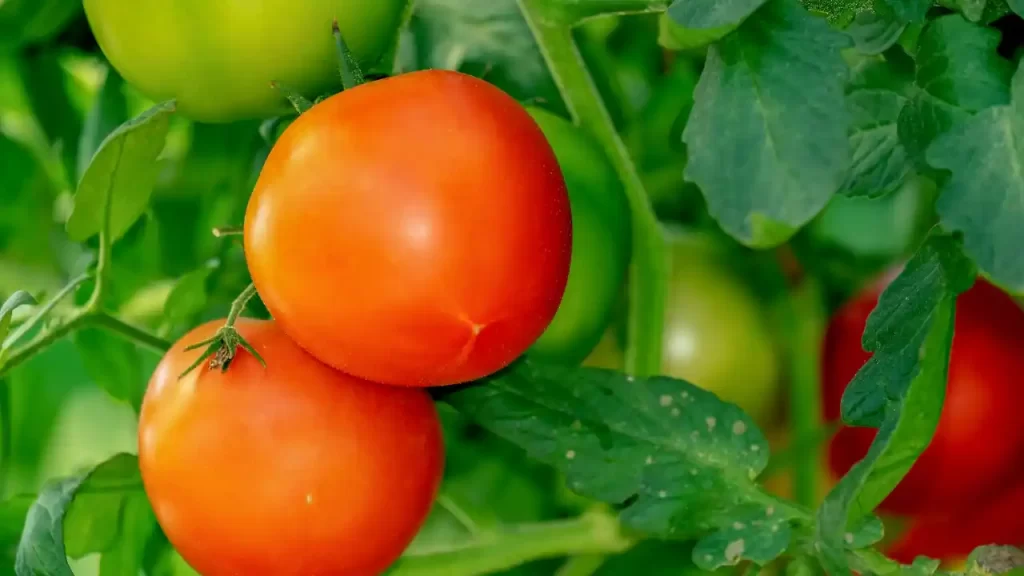
Pruning of leaves in tomato plants results in fewer fruits. But if leaves are pruned at the right time, the plant utilizes its energy to produce bigger fruits.
The fruits would be able to absorb more nutrients, and hence the quality of tomatoes is also enhanced.
The pruned plants have limited growth so more plants can be grown on the ground and easily make up the tomato harvest.
You can grow bigger and quality fruits just by pruning the leaves of tomato plants.
Earlier ripening
Due to pruning, the tomato plants could set very few tomatoes. Thus it becomes easier for the plant to complete the ripening process rapidly.
Due to frost, it is always challenging to ripen the tomatoes at the end of the season. Thus pruning helps the tomato plants in the early ripening of the tomatoes.
How To Prune Tomato Plants?
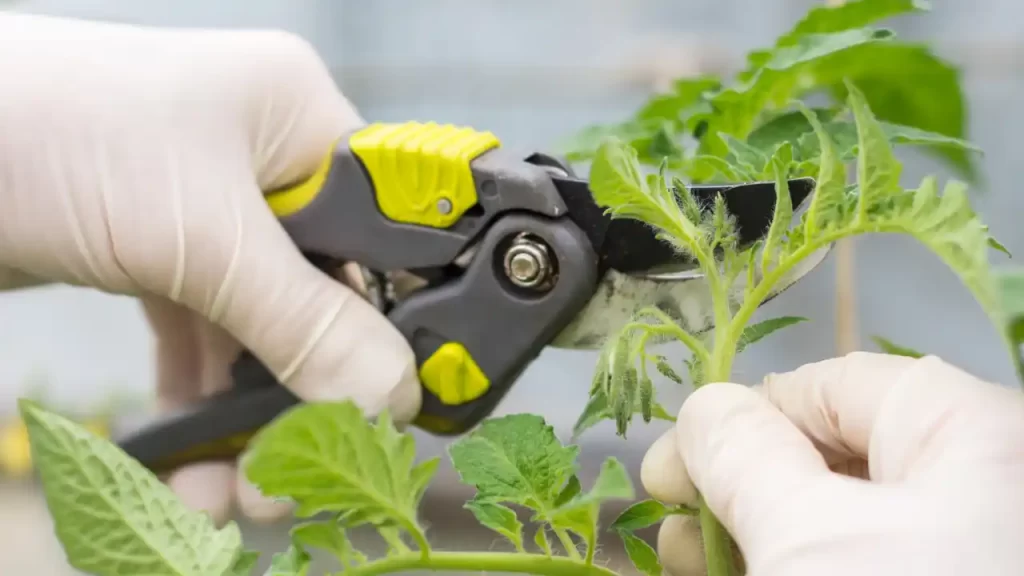
Pruning tomato plants has various advantages, but if not pruned correctly, it can destroy your tomato plant.
To avoid excessive pruning and know the correct technique for clipping your tomato plants, follow the below-discussed techniques.
Simple Pruning
When new “V” shaped branches, also known as suckers, grow between the main stem and the branches, you should prune them along with the fruits grown on them to save the plant’s energy.
It also prevents the plant from various possible diseases and the crowding of plants.
You should pinch the suckers as and when you spot them (up to 2 inches), and if they become bigger, pruning becomes necessary.
Missouri Pruning
Suckers grow very fast, and if they have grown bigger, pruning them can result in shock to your tomato plants.
To avoid this shock, the tip of the suckers are pinched and some of the leaves are left which protects the developing tomatoes from sunburn. This process is called Missouri Pruning, and this method is useful when things are out of control, i.e., the suckers are overgrown, especially in hot climates.
But the main disadvantage of this pruning is the remaining part of the suckers will grow new suckers, which requires regular pruning.
What is “root pruning” and when should you do it?
Some gardeners believe that “Pruning the roots” strengthens their tomato plants. Root cutting results in a decline in the plant’s growth, and plants mature more than they would have been before.
You can prune the roots of your tomato plants when the few batches of tomatoes start to ripen.
You can use a kitchen knife, hoe or pitchfork to prune the roots. Insert any equipment inside the soil and penetrate up to 8-10 inches from the plant base. Make your cut just half away around the plant.
Pruning Cautions
Pruning tomatoes is a very risky process and therefore you need to be extra cautious while performing this process for your plants.
I have listed a few points below, which I keep in mind while pruning my tomato plants.
Don’t over-prune in hot climates.
Pruning the tomato plants in hot climates can damage them. If you grow your tomato plants in hot regions, pruning won’t be healthy for your plant. Excessive sunlight can develop sunscald due to the pruning process.
Go easy on pruning determinate varieties
If you have determinate varieties of tomatoes, please remember that they can grow tomatoes in bulk at once. Very few tomatoes are produced at the end of the season.
It is better not to prune determinate varieties, or else you need to compromise your yield.
Instead, you can pinch the suckers from determinate tomatoes to get quality and tasty tomatoes as they continuously grow and produce fruit till the beginning of the frost.
Is pruning absolutely necessary?
Pruning is not at all necessary for the survival of tomato plants. You can choose not to prune your tomato plants and still get quality and large numbers of tomatoes.
Your tomato plants need good sunlight exposure, proper watering, and nutrient-rich soil to survive and set fruits. Proper Pruning can enhance the quality, size and number of fruits on your tomato plants.
Why Do Tomato Plants Grow Side Stems and Suckers?
When tomatoes get enough sunlight, they are totally filled with energy. They use their energy in the beginning week to produce maximum leaves before blooming. They also develop new branches, and new leaves emerge on those branches.
New branches are developed between the main stem and branches in a V shape called suckers, whereas side stems can be seen growing directly from the main stem.
With the growth of tomato plants, more energy is produced by tomato leaves, which is the main reason for the growth of suckers and side stems.
If the plant is developing suckers between the middle to end of the season, they are damn weak and produce bad quality fruits.
Bottom suckers are comparatively stronger than the top ones as the sugar concentration is decreased at the top part of the plant.
What Parts of Tomato Plants Should be Pruned?
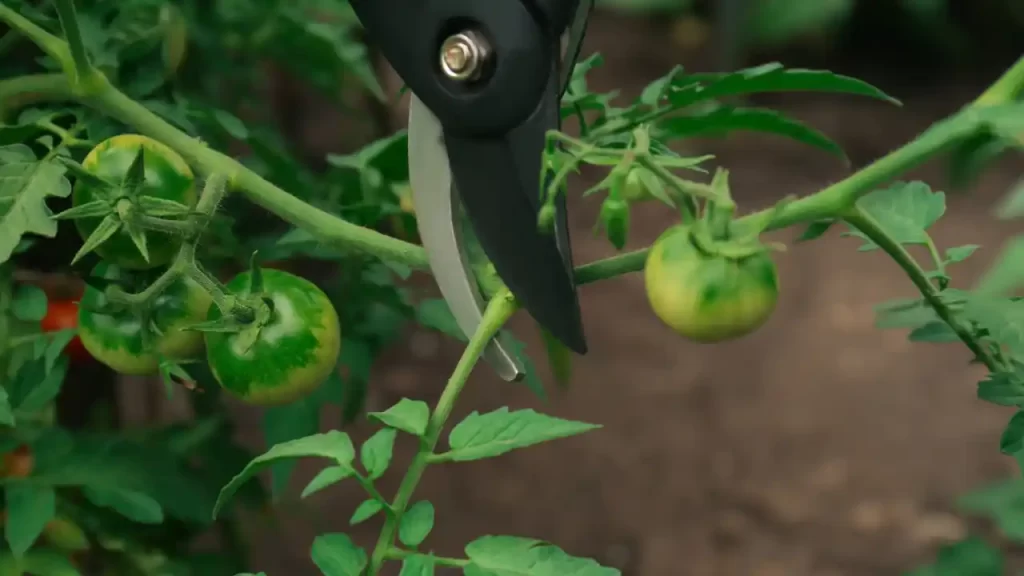
You should prune tomato plants to encourage healthier plants growth and improve yields. Generally, you should prune the terminal ends or tops of the plant away. This will promote lateral branch development, which produces more fruit-bearing branches and a bushier shape for the tomato plant.
If you find any dead or diseased branches, you must prune them, so the disease does not spread to the rest of the plant.
Pruning off leaves and stems in the center of the plant can help prevent fungal diseases, such as blight and powdery mildew, by allowing for better air circulation.
Also, the suckers (the shoots that grow in between two leaf nodes) should be pruned away to focus the plant’s energy on producing fruit.
As tomatoes grow, you should remove new suckers regularly. Pruned tomato plant ensure a healthy and productive harvest season.
Which leaves to remove from tomato plants?
When pruning tomato plants, it is important to remove the sucker growth. The suckers take away essential nutrients and water from the main plant.
You should also remove any dead or diseased leaves, as they can spread infection and reduce the plant’s overall health.
Finally, if you see any yellow or wilted leaves, you should remove them to prevent the spreading of disease and pests that can feed on them.
Summary
Though pruning is not necessary for your tomato plants, it can reward you with high-yield and quality tomatoes. It can also reduce the risk of diseases and result in stronger plants. But it is important to be cautious while pruning your plant as it is a very delicate process, and over-pruning can even destroy your tomato plants.
Also, figure out the weather condition and variety of the planted tomatoes before pruning your tomato plants.
Avoid pruning in hot climates; only suckers should be pinched if planted with determinate varieties of tomato. Thus if pruning is done diligently, it will definitely reward you with better yield.
Recent Posts
Are you ready to plant tomatoes for the best tomato harvest of your life? It all starts with getting the fertilizer right! Fertilizing tomatoes can seem daunting, but when done correctly, it’s...
9 Reasons Why Your Tomato Plants Wilting and How To Fix This!
When the gardeners see their lovely and precious tomato plants wilted, they become hopeless, sad, and impatient. But the situation can often be reversed with proper care and adopting a few good...
